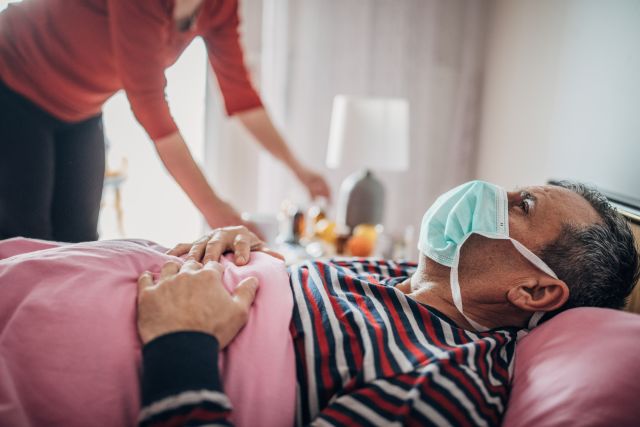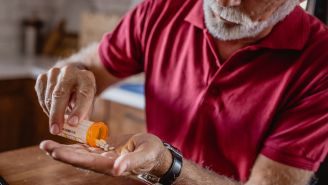Updated on December 16, 2024.
COVID is often associated with fever, cough, fatigue, and other general signs of a respiratory infection. But this infection affects more than just the lungs. In more serious cases, it can also cause damage to the heart, brain, kidneys, and other organs.
More severe infections may trigger serious and potentially life-threatening symptoms. Serious infection can develop slowly, but sometimes it happens very quickly. Red flags may include:
- Difficulty breathing or catching your breath
- Persistent pain or pressure in the chest
- New confusion or disorientation
- Discolored lips, skin, or nail beds—depending on skin tone, these might look blue, pale, or gray
- Loss of consciousness or difficulty waking up or staying awake
It’s important to seek immediate medical attention if you develop any of these serious warning signs. Call 911 right away and let the operator know that you have or think you may have COVID-19.
Other serious symptoms might come up, so if you’re concerned about a symptom, even if it’s not on this list, consult an HCP.
Who is at risk of severe COVID symptoms?
Most people with COVID won’t need emergency treatment. Many people will not even have symptoms. But your chance of experiencing severe symptoms rises with how many risk factors you already have.
Being age 65 or older raises your risk the most, according to the Centers for Disease Control and Prevention (CDC). More than 81 percent of deaths from COVID happened to older people. Having other serious medical conditions can also raise your risk of severe illness from COVID. These include (but aren’t limited to):
- Overweight and obesity
- Heart disease
- Diabetes
- Chronic lung, liver, or kidney diseases
- Asthma
- Sickle cell disease
- Stroke
- Cancer
- Intellectual or developmental disabilities
People with a weakened immune system, from infections like HIV, or who are undergoing chemotherapy, are also at higher risk.
Behavior can affect your risk level, too. People who are physically inactive, who currently smoke or smoked in the past, or have substance use disorders like alcohol, cocaine, or opioid use disorders are also at much higher risk of serious illness from COVID.
Why some cases become life-threatening
When people who have many risk factors get infected with COVID, the virus can cause a number of problems besides typical mild-to-moderate symptoms. Their immune systems may go into overdrive. Cytokines, which are molecules that help regulate inflammation in the body, can be affected and cause intense inflammation. Too much systemic inflammation is called a cytokine storm, and it can be deadly.
Severe coronavirus infections could also lead to pneumonia. This happens when the infection triggers inflammation in the lungs' air sacs (alveoli), causing them to fill up with fluid and making it hard to breathe. People with pneumonia may also develop severe coughing along with fever and chills. Sometimes a person with COVID, whose immune defenses are already down, could also become infected with bacterial pneumonia.
In extreme cases, COVID can lead to acute respiratory distress syndrome (ARDS) and death from respiratory failure. Since the lungs aren’t working as well as they should, the amount of oxygen in the bloodstream drops. When the rest of the body isn’t getting the oxygen its needs, the brain, heart, and other vital organs can be damaged or fail.
The most important way to prevent severe symptoms from COVID is to stay up to date on your COVID vaccinations. These vaccines are safe and effective. The CDC recommends that people ages 6 months and older get the latest Pfizer-BioNTech, Moderna, or Novavax vaccines.
A preventive monoclonal antibody medication called pemivibart (Pemgarda) can also help add a layer of protection.
How severe COVID may be treated
Treatments for patients with severe COVID may include:
- Oxygen support, which can help the body get the oxygen it needs until the lungs are able to recover
- Antiviral drugs like remdesivir, baricitinib (Olumiant), and tocilizumab (Actemra)
- Corticosteroids, such as dexamethasone, which are used to suppress the immune system and ease inflammation, swelling, and edema
- Convalescent plasma, which is a liquid filled with antibodies collected from people who have recovered from COVID
- IV fluids, blood thinners, and other medication to treat COVID-related complications
What to do if you have COVID symptoms or test positive
Symptoms of COVID may appear anywhere from two to 14 days after exposure to the virus.
If you have symptoms of COVID that are not severe or life-threatening and do not require immediate medical attention, such as cough, fever, chills, sore throat, or new loss of your sense of smell, take immediate steps to avoid spreading the illness to others. This means wearing a face mask and keeping distance between yourself and others. You can also call your HCP to discuss the best treatment options for you.







